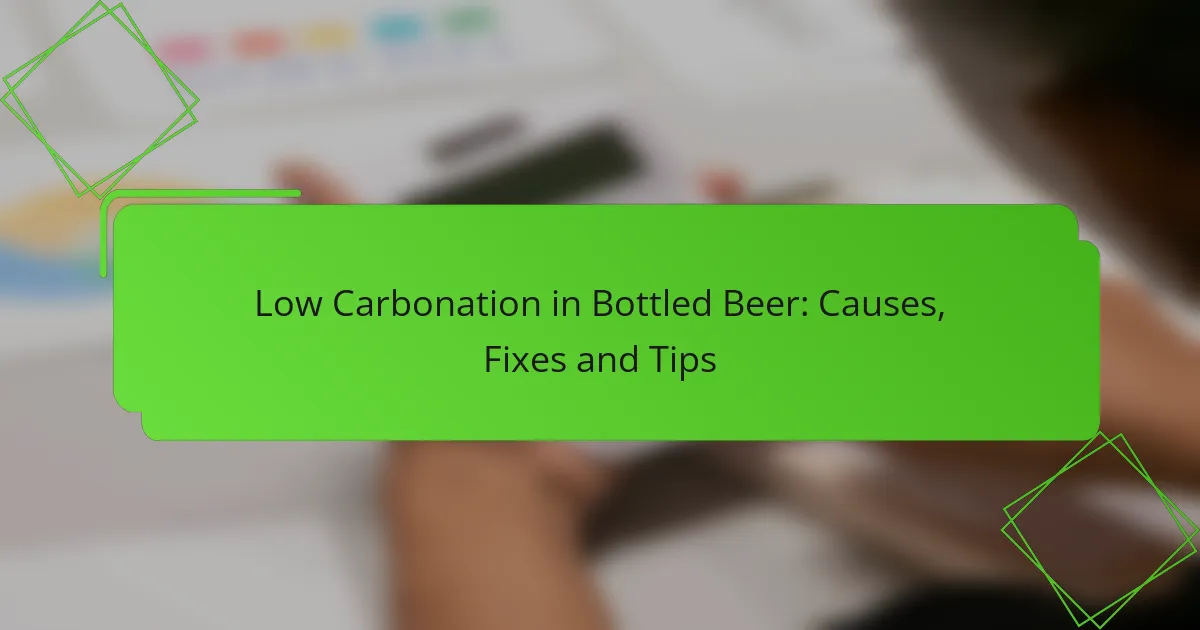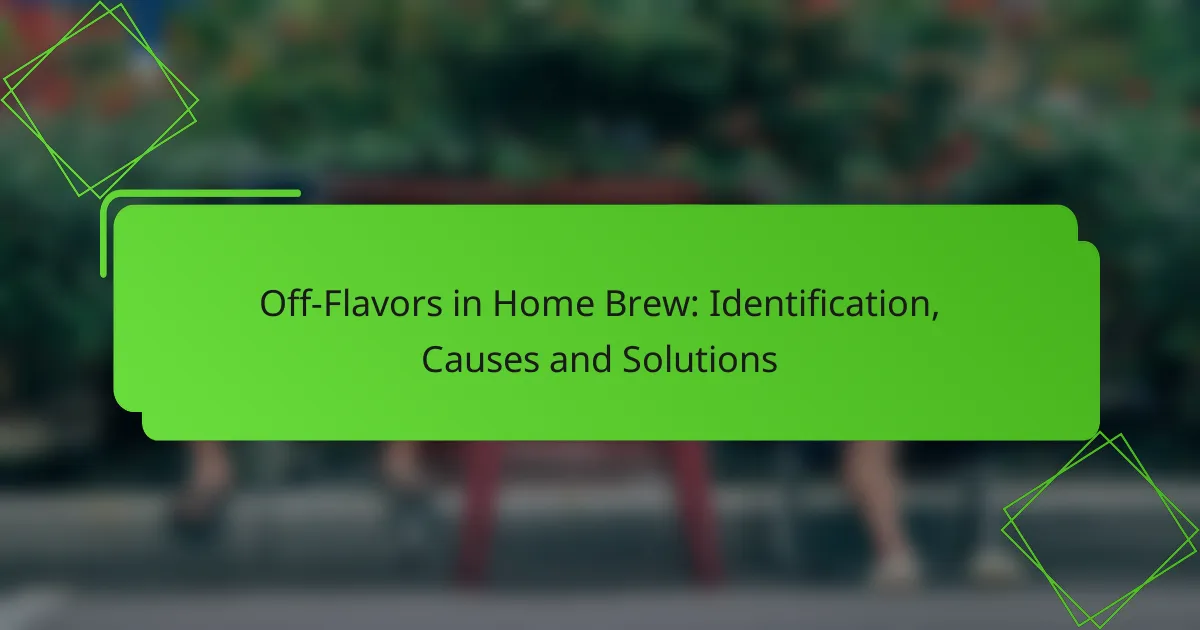Low carbonation in bottled beer can detract from the overall drinking experience, often stemming from issues related to fermentation, packaging, or storage. Understanding the underlying causes is essential for brewers and consumers alike to effectively troubleshoot and enhance carbonation levels. By implementing targeted fixes such as adjusting fermentation practices and optimizing storage conditions, the quality and enjoyment of the beer can be significantly improved.
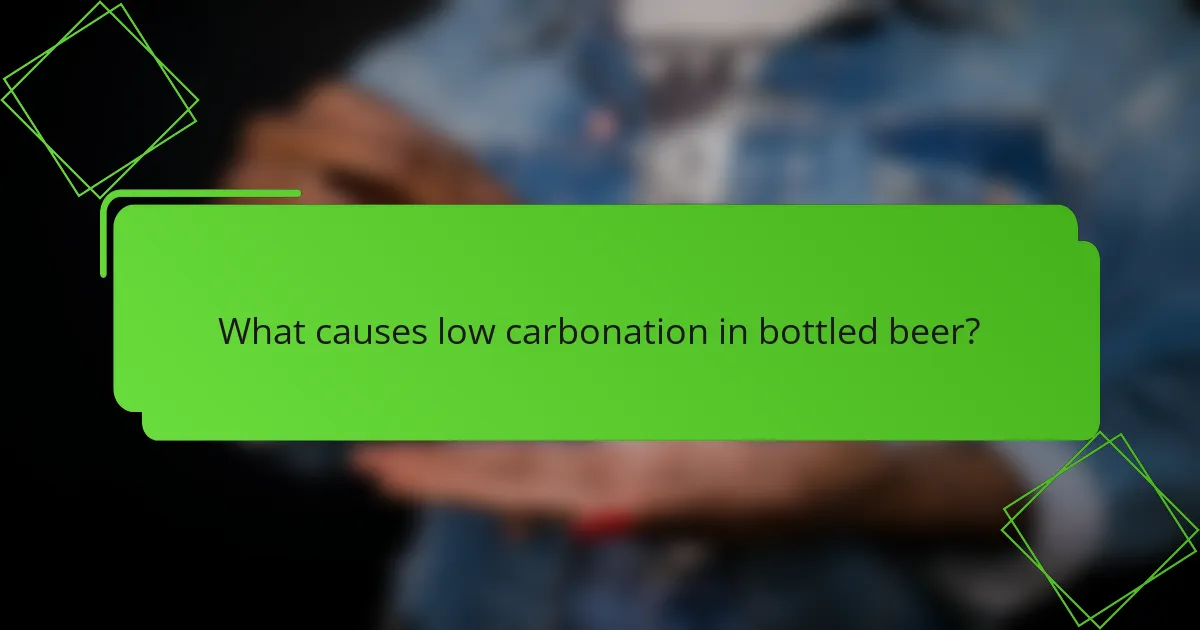
What causes low carbonation in bottled beer?
Low carbonation in bottled beer can result from several factors, including fermentation issues, packaging methods, storage conditions, and the choice of beer style. Understanding these causes can help brewers and consumers identify and address carbonation problems effectively.
Improper fermentation process
An improper fermentation process can lead to insufficient carbonation in bottled beer. If fermentation is incomplete, not enough carbon dioxide is produced, resulting in flat beer. Ensuring that yeast is healthy and fermentation temperatures are optimal is crucial for achieving the desired carbonation levels.
Brewers should monitor fermentation closely, checking specific gravity readings to confirm that fermentation has reached completion. If fermentation is halted prematurely, additional sugar or priming sugar can be added before bottling to encourage carbonation.
Inadequate carbonation during packaging
Inadequate carbonation during the packaging phase can also lead to low carbonation levels in bottled beer. If the beer is not properly carbonated before bottling, it will lack the necessary bubbles. This can occur if the carbonation process is rushed or if the wrong amount of priming sugar is used.
To avoid this issue, brewers should carefully calculate the amount of priming sugar based on the beer style and desired carbonation level. Using a carbonation calculator can help ensure accurate measurements and improve the final product.
Temperature fluctuations during storage
Temperature fluctuations during storage can negatively impact carbonation levels in bottled beer. If beer is stored at inconsistent temperatures, it can affect yeast activity and carbonation retention. Ideally, beer should be stored in a cool, stable environment to maintain its carbonation.
Brewers and consumers should aim to store bottled beer at temperatures between 45°F and 55°F (7°C to 13°C). Avoiding extreme temperature changes can help preserve carbonation and overall beer quality.
Use of low-carbonation beer styles
Some beer styles are naturally low in carbonation, which can lead to a perception of flatness. Styles like certain stouts and porters may have lower carbonation levels due to their ingredients and brewing methods. Understanding the characteristics of these styles can help set expectations for carbonation.
When choosing a low-carbonation beer, it’s essential to appreciate that this is often a deliberate choice by the brewer. If a higher carbonation level is desired, opting for styles like lagers or IPAs may be more suitable.

How can low carbonation in bottled beer be fixed?
Low carbonation in bottled beer can be addressed through several methods, including re-carbonation techniques, adjusting fermentation practices, and ensuring proper storage conditions. Each approach has its own considerations and can significantly improve the beer’s overall quality.
Re-carbonation methods
Re-carbonation involves adding carbon dioxide back into the beer to achieve the desired fizziness. This can be done by force carbonating with a CO2 tank or by adding priming sugar before bottling, which allows the yeast to produce additional CO2 during fermentation. The choice of method depends on the equipment available and the desired level of carbonation.
For force carbonation, a common practice is to set the CO2 pressure to around 10-12 PSI for a few days at a cool temperature. For natural carbonation, adding about 3/4 cup of corn sugar to five gallons of beer is a typical guideline. Monitor the carbonation levels to avoid over-carbonation, which can lead to gushing upon opening.
Adjusting fermentation techniques
Improper fermentation can lead to low carbonation levels in bottled beer. Ensuring that fermentation is complete before bottling is crucial; otherwise, the yeast may not produce enough CO2. Use a hydrometer to check specific gravity and confirm fermentation is finished.
Additionally, maintaining optimal fermentation temperatures is vital. Most ales ferment best between 65-75°F (18-24°C), while lagers prefer cooler temperatures around 45-55°F (7-13°C). Consistent temperatures help yeast activity and improve carbonation levels.
Ensuring proper storage conditions
Storage conditions play a significant role in maintaining carbonation in bottled beer. Bottles should be stored upright in a cool, dark place to prevent light exposure and temperature fluctuations, which can affect carbonation and flavor. A temperature range of 50-55°F (10-13°C) is generally ideal for most beers.
Avoid storing beer in areas with high humidity or extreme temperatures, as these can lead to bottle spoilage or carbonation loss. Regularly check the bottles for any signs of leakage or sediment, which may indicate issues with carbonation or fermentation.

What tips can improve carbonation levels in bottled beer?
Improving carbonation levels in bottled beer involves careful attention to yeast selection, fermentation temperature, and priming sugars. By optimizing these factors, brewers can achieve a more consistent and desirable fizziness in their final product.
Choosing the right yeast strains
Selecting appropriate yeast strains is crucial for achieving desired carbonation levels. Different yeast varieties produce varying amounts of carbon dioxide during fermentation, so choosing a strain known for its carbonation efficiency can make a significant difference.
For example, ale yeasts typically produce more carbonation than lager yeasts. Consider using strains specifically designed for bottle conditioning, as they are often more reliable in generating the necessary CO2 for proper fizziness.
Monitoring temperature during brewing
Temperature control during fermentation is essential for optimal yeast activity and carbonation. Yeast performs best within specific temperature ranges, usually between 18°C to 24°C for ales and 7°C to 13°C for lagers.
Inconsistent temperatures can lead to under- or over-carbonation. Use a thermometer to monitor fermentation temperatures closely, and consider using temperature control systems if brewing in fluctuating environments.
Using appropriate priming sugars
Priming sugars are added to beer before bottling to encourage carbonation. Common options include corn sugar, table sugar, and dry malt extract, each providing different levels of fermentable sugars.
A general guideline is to use about 4 to 6 ounces of priming sugar for a 5-gallon batch, but this can vary based on the beer style and desired carbonation level. Always calculate the amount based on the specific gravity of the beer to avoid over-carbonation, which can lead to gushing or bottle bombs.
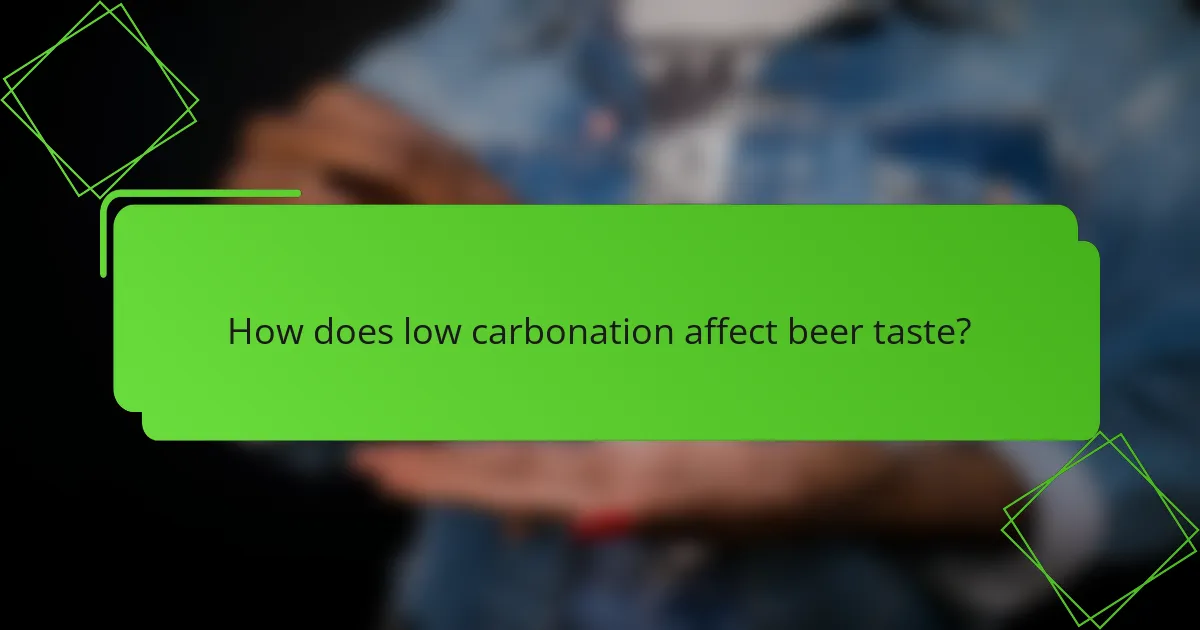
How does low carbonation affect beer taste?
Low carbonation can significantly alter the taste of beer, leading to a flat and less enjoyable drinking experience. Carbonation enhances flavors and aromas, so insufficient bubbles can mute the beer’s intended profile.
Impact on flavor perception
Carbonation plays a crucial role in how we perceive flavors in beer. When carbonation levels are low, the release of volatile compounds that contribute to aroma is diminished, resulting in a less aromatic and flavorful experience. This can make even well-crafted beers taste bland or unbalanced.
For example, a pale ale with low carbonation may lack the bright citrus notes typically associated with the style, making it taste dull. Maintaining proper carbonation levels is essential for preserving the intended flavor profile of various beer styles.
Influence on mouthfeel
The mouthfeel of beer is heavily influenced by carbonation, which adds a sense of liveliness and texture. Low carbonation can lead to a watery or thin mouthfeel, detracting from the overall drinking experience. This is particularly noticeable in styles like stouts or porters, where a creamy mouthfeel is expected.
To ensure an optimal mouthfeel, aim for carbonation levels that align with the beer style. For instance, lagers typically require higher carbonation than ales. Adjusting serving temperature can also enhance mouthfeel; colder beers often feel crisper, while warmer beers may feel fuller.

What are the best practices for bottling beer?
To ensure quality and carbonation in bottled beer, best practices include proper sanitization, selecting suitable bottles, and monitoring the bottling process closely. These steps help prevent contamination and maintain the desired carbonation levels.
Proper sanitization techniques
Sanitization is crucial in the bottling process to avoid unwanted bacteria and wild yeast that can spoil the beer. Use a no-rinse sanitizer, such as Star San, to clean all equipment, including bottles, caps, and siphon tubes. Ensure that everything is thoroughly sanitized just before use.
It’s advisable to soak bottles in a sanitizing solution for several minutes, then let them drain without rinsing. This method helps maintain the effectiveness of the sanitizer while ensuring that no contaminants are introduced during bottling.
Choosing suitable bottles
Selecting the right bottles is essential for maintaining carbonation and preventing breakage. Glass bottles are preferred, with brown or green glass providing better protection from light, which can degrade beer quality. Standard 12-ounce or 22-ounce bottles are common choices.
Consider using bottles designed for carbonation, such as those with thicker glass or specific pressure ratings. Avoid reusing bottles that previously contained non-carbonated beverages, as they may not withstand the pressure from carbonated beer.
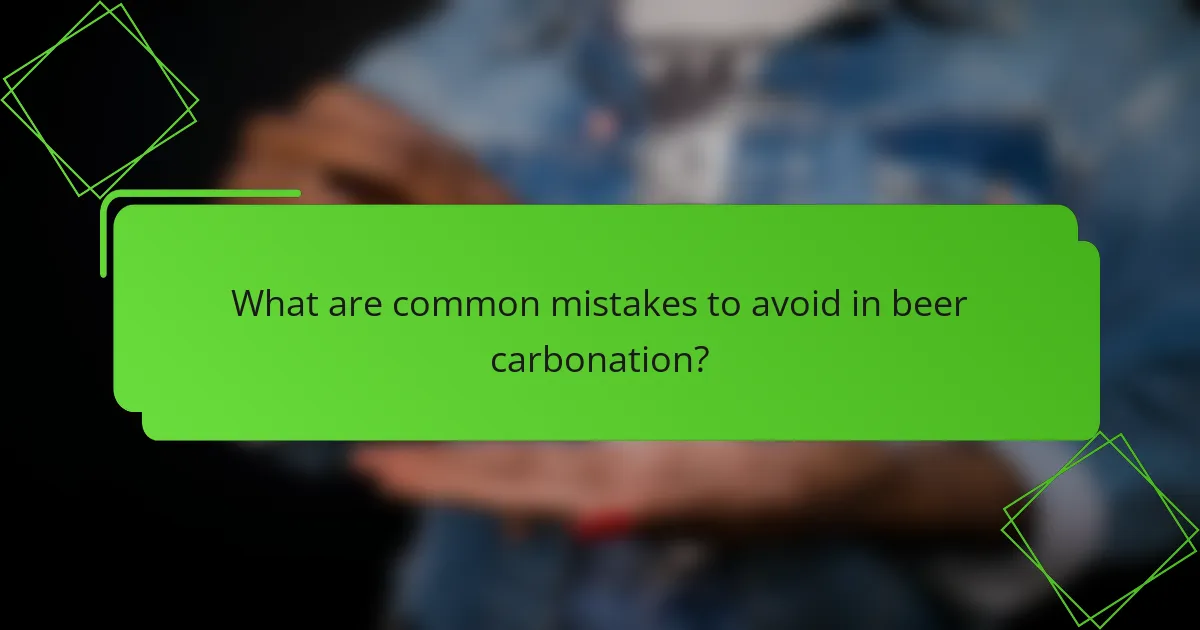
What are common mistakes to avoid in beer carbonation?
Common mistakes in beer carbonation can lead to low carbonation levels, affecting the overall quality and enjoyment of the beer. Understanding these pitfalls is crucial for achieving the desired fizziness and mouthfeel in your bottled beer.
Over-priming or under-priming
Over-priming occurs when too much sugar is added before bottling, leading to excessive carbonation and potential bottle bombs. Conversely, under-priming results in insufficient carbonation, leaving the beer flat and unappealing. Both scenarios can stem from miscalculating the amount of sugar needed based on the beer style and fermentation conditions.
To avoid these issues, use a reliable priming sugar calculator that factors in factors like the beer’s temperature and style. Typically, a range of 3/4 to 1 cup of corn sugar is used for a standard 5-gallon batch, but this can vary. Always measure carefully to ensure consistent results.
When bottling, consider the fermentation stage of your beer. If fermentation is incomplete, adding priming sugar can lead to over-carbonation. Always check specific gravity readings to confirm fermentation is finished before priming.
